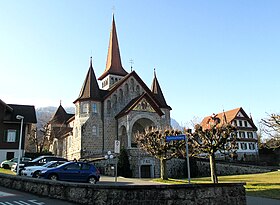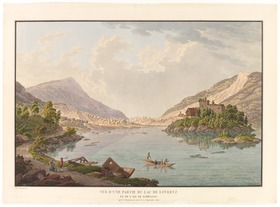Goldau
| Goldau | ||
|---|---|---|
| State : |
|
|
| Canton : |
|
|
| District : | Schwyz | |
| Municipality : | Arth SZ | |
| Postal code : | 6410 | |
| former BFS no. : | ? | |
| UN / LOCODE : | CH GOL | |
| Coordinates : | 684 523 / 211484 | |
| Height : |
510 m above sea level M. |
|
| Resident: | 5437 (December 31, 2007) | |
| Website: | www.arth.ch | |
| map | ||
|
|
||
Goldau is a village in the political municipality Arth SZ , in the canton of Schwyz , in Switzerland .
geography
The village of Goldau lies in the valley floor between Lake Zug and Lake Lauerz , at the foot of Rossberg and Rigi .
story
The history of Goldau is strongly influenced by numerous landslides and the construction of various railways ( Gotthardbahn , Südostbahn , Arth-Rigi-Bahn ).
When people talk about the Goldau landslide, what is usually meant is that of 1806, although a total of around 20 landslides are known and although the medieval landslide of Oberarth in the 14th century was of greater importance for the formation of the landscape today , as the fall tore down larger boulders than that of 1806. Despite the larger boulders, the fall in the 14th century covered a smaller area than that of 1806. The largest boulders were up to 636 m above sea level. M. thrown up, 50 meters higher than that of 1806. The fall caused the damming of the Muota and the creation of the Lauerzersee . A major slide in the recent past occurred in 2005, but on a scale that cannot be compared with that of 1806.
The development of Goldau lasted through the centuries from a few settlements by farmers. Goldau was first mentioned in a document in 1353 . The word "Goldau" has nothing to do with gold, but is derived from the word "golet" (= rubble), ie the "rubble-au".
The stone chapel was built in 1652. In 1701 Goldau became its own parish through a deed from Arth .
After the landslide in 1806 with 457 deaths, many new houses were built, e.g. B. 1810 the Pfrundhaus as a church, school and meeting house or 1811 the restaurant Rössli. A farmhouse was moved one meter away from its foundation by the landslide, demolished in 1812 and rebuilt at its current location on Gotthardstrasse (today's restaurant farm ). The first chapel after the landslide was built between 1830 and 1849 . In 1888 there were 380 inhabitants, including about 60 school children. In 1906 today's Herz-Jesu Church was built from Nagelfluhsteinen.

Goldau experienced the great boom through the construction of the railway, initially the Arth-Rigi-Bahn in 1875. As a rack and pinion railway , it travels from Arth to the Rigi. In 1882 the Gotthard railway line was built from rubble from the landslide of 1806. Initially, they wanted to create it in the Arther valley basin. However, the excavation of the tunnel towards Steinen was associated with great difficulties. The reason was the landslide rubble.
Due to the construction of the railway, around 18 hotels and restaurants were built in Goldau. This necessity was required mainly for the 1000 Italian workers, as they were also used for the renovation of the Arth-Rigi railway. A new railway connected to the Gotthard Railway , the Südostbahn (SOB). The Arth-Goldau – Biberbrugg (- Rapperswil ) line, which was opened in 1894 , made Goldau an important railway junction in central Switzerland .
Six years later, in 1897, the Thalwil - Zug - Arth-Goldau line was built. This required the station to be relocated to a new location or today's signal box. The Arth-Rigi-Bahn was also moved to today's high platform. The original starting point was the square next to the old station building.
The second Gotthard railway line was built in 1902, and the Arth-Rigi Railway was electrified in 1906. The transfer of the Gotthard Railway Company to the Swiss Federal Railways (SBB) was completed in 1909. The electrification of the SBB lines took place in 1921 , for which the Arth-Rigi-Bahn had to raise the high platform by 41 cm because of the contact line. In 1910, 2000 inhabitants were registered.
According to a design by the painter Anton Mettler, the Goldau coat of arms was publicly installed in the old Pfrundhaus in 1927.
The Goldau nature and animal park was created in 1925 . As the owner, SBB made the 4000 m² floor available. The landslide museum opened its gate in 1956.
In 1970 the SABE publishing house was founded by the Sauerländer and Benziger publishing groups at the Goldau Conference .
The Eichmatt parish center was built from 1975 to 1982.
population
| Population development | |
|---|---|
| year | resident |
| 1860 | 434 |
| 1905 | 1604 |
| 2000 | 5285 |
| 2007 | 5437 |
The population development of Goldau was slowed down considerably by the Goldau landslide of 1806. After that, the population of Goldau grew strongly, mainly due to the construction of the Gotthard Railway . Meanwhile, many commuters live in Goldau, as the village is optimally accessible by the railroad and the motorway.
traffic
The important Arth-Goldau railway junction is located in Goldau . The lines from Zurich via Zug , from Lucerne and from Pfäffikon SZ via the Seedamm meet here . They unite to form the SBB - Gotthard line . Since the Arth-Rigi-Bahn stopped operating the valley line to Arth, its starting point is also at Arth-Goldau station and leads to the Rigi .
The A4 motorway runs south of Goldau along the foot of the Rigi. There is a motorway connection in Goldau.
Business
There is a balanced spectrum of employment opportunities in Goldau. There are numerous jobs in the areas of cable car construction ( Garaventa AG ) and metal construction (Kaufmann AG). In the service sector, tourism, rail operations and transport are important. The Schwyz University of Education is also located in Goldau .
particularities
The village was completely destroyed in the Goldau landslide in 1806 and has been rebuilt since then. This event had a decisive impact on the image of the village, as no house, with one exception, is more than 200 years old.
gallery
Rigibahn saddle station
Attractions
- Rockslide museum about the rockslide there in 1806
- Zoo
- Rigi
Personalities
Sons and daughters
- Thury Horath - country musician
- Marco Jorio - historian and editor-in-chief of the Historical Lexicon of Switzerland
- Franz Marty - Chairman of the Board of Directors of Raiffeisen Switzerland and member of the Bank Council of the Swiss National Bank
- Tamara Müller - ski racer
literature
- Karl Zay : Goldau and its region, how it was and what it has become . Orell, Füssli and Compagnie, 1807, p. 390 ( full text in Google Book Search).
- Josef Niklaus Zehnder: The Goldau rockslide - its time and its precipitation . 3. Edition. Goldau landslide museum, 1988 ( excerpt from Chapter X on the subject of Goldau becoming a railway junction [accessed on February 15, 2018]).













